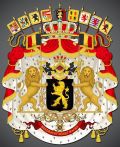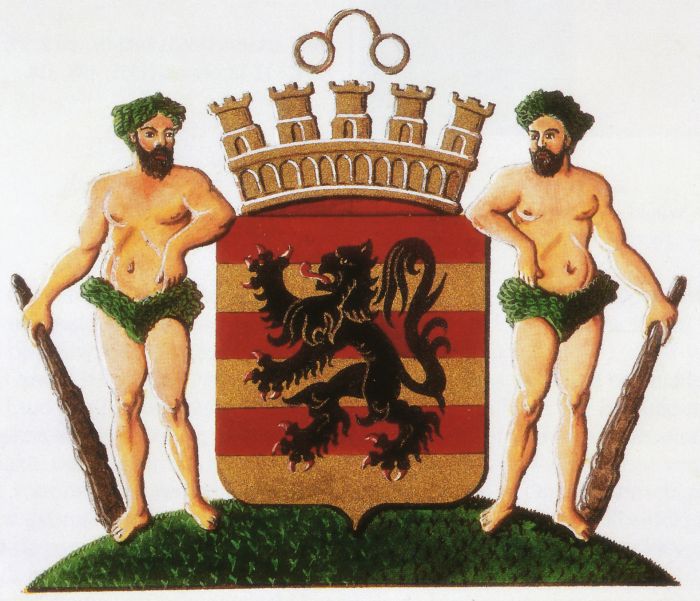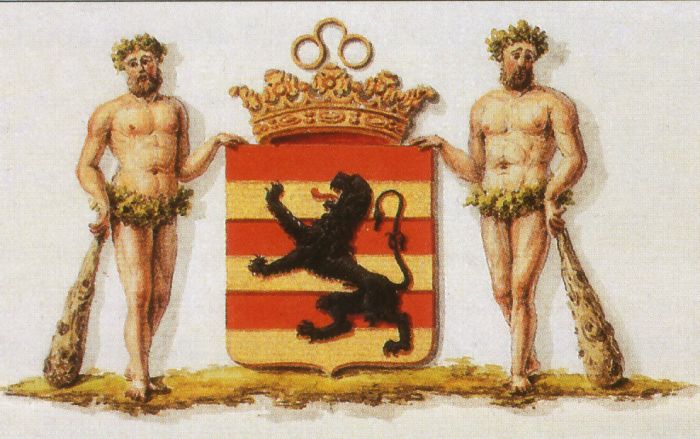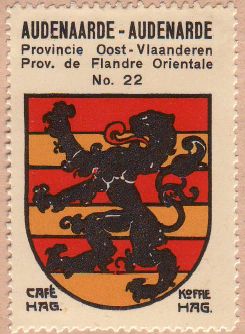Oudenaarde
Belgium heraldry portal
This page is part of the Belgium heraldry portal |
Heraldry of the World |
|
Civic heraldry:
|
Other heraldry: |
OUDENAARDE
Province : Oost-Vlaanderen
Additions : 1964 Bevere, Edelare, Eine, Ename, Leupegem, Nederename, Volkegem; 1970 Heurne, Mater, Melden, Welden; 1977 Mullem
Official blazon
- (1819) Gedwarsbalkt van rood en goud van zes stukken, verzeld van een klimmende zwarte leeuw, met een roode tong, loopende over het geheel. Het schild gedekt met een kroon waarop een bril, beide van goud, het wapen ter wederzijde vastgehouden door een wildeman.
- (1838) Fascées de gueules & d'or à un lion de sable, lampassé de gueules, brochant sur le tout, l'écu ayant pour timbre une couronne d'or sommée d'une paire de lunettes de même, et pur tenants deux hommes sauvages au naturel avec leur massue.
- (1992) Gedwarsbalkt van zes stukken van keel en van goud, met over alles heen een leeuw van sabel, geklauwd en getongd van keel. Het schild getopt met een stedekroon met vijf torens van goud, overtopt met een bril van hetzelfde, en gehouden door twee wildemannen van vleeskleur, omgord en gekroond met bladeren van sinopel en steunend op een knots van natuurlijke kleur. Het geheel op een grasgrond geplaatst.
Origin/meaning
The arms were granted on September 28, 1819, confirmed on May 29, 1838 and again granted on October 6, 1992 with a new type of crown and red nails for the lion.
| The arms of 1819 and 1838. |
The arms of Oudenaarde first appear on the seal of the city dating from 1339. The arms are a combination of the oldest arms of the Looz family and the lion of Vlaanderen. Gerard, Lord of Oudenaarde in the early 14th century descended from the Looz family. The city was one of the main cities in Vlaanderen and had received city rights in 1190. Hence the use of the lion of Vlaanderen in the arms.
The colours are known from around 1500, with the lion completely black. During the centuries the arms have been barred of red and gold, or gold and red, and the lion has been fully black, or armed of red or silver. In 1819 the arms were granted based on the oldest coloured image, but with a red tongue. In 1992 the lion also got red nails.
The basic design of the arms never changed during the centuries, but the arms have been shown with a variety of crowns and supporters. On the old seals the arms are hanging on a tree, or have two dragons as supporters. The present savages were appear in the late 18th century, at the same time, but not on the same seal, as the glasses above the shield.
The meaning of the glasses above the arms is not known, it has been speculated that these have been granted by Emperor Charles V in the early 16th century. Another explanation is that the glasses were originally a letter A on the seal (from Audenaaerde). Both theories have not been proven and the origin, or meaning, thus remain unknown.
The present crown, a mural crown, was added in 1992 to indicate that the town used to have fortifications, this crown, however, never appeared on historical seals or images.
| The arms in 1562 |
The arms in the Koffie Hag/Café Hag albums +/- 1930 |
| The arms on a police badge (source) |
Contact and Support
Partners:
Your logo here ?
Contact us
© since 1995, Heraldry of the World, Ralf Hartemink
Index of the site
Literature : Servais, 1955






